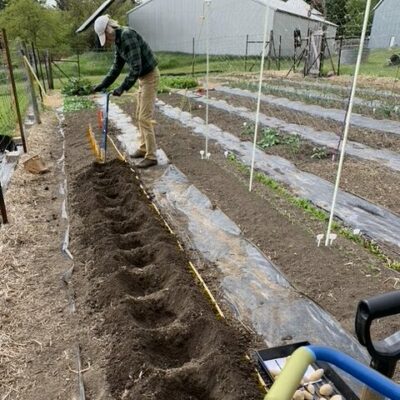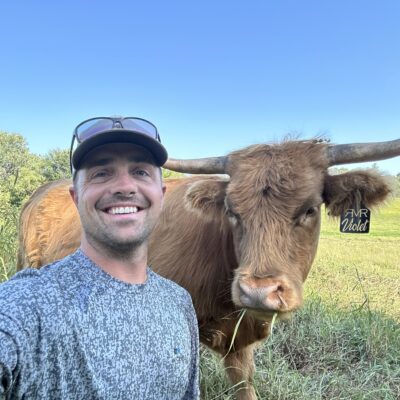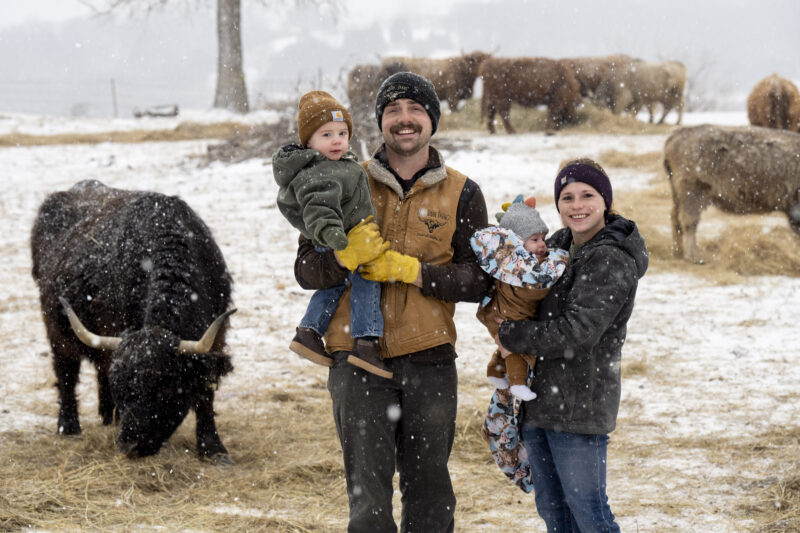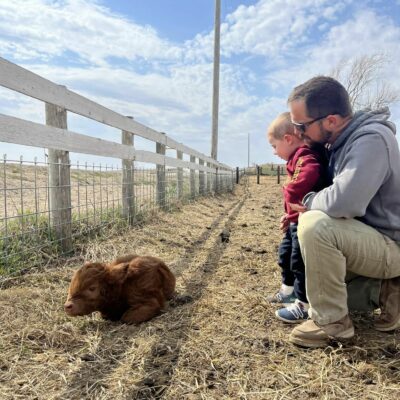Climate Land Leaders Maggie McQuown and Matt Vermeersch of Red Oak, IA, recently shared their (ongoing!) story of what Maggie calls an “intergenerational passing of the baton” – their process of transitioning stewardship of the land from one family to another. Maggie McQuown and her husband Steve Turman own Resilient Farms. Matt and Jocelyn Vermeersch operate Mud Ridge Ranch.
An intergenerational passing of the baton
Maggie

Steve and I began our journey toward a next generation on the farm shortly after moving to my family’s Century Farm in 2012. We looked at the farm and realized it had changed greatly since my growing up there in the 1950s and 1960s. We recognized issues associated with production mono-crop farming systems which are unsustainable with limits to growth and contributing to the impending climate crisis.
After joining Practical Farmers of Iowa we started attending conferences, learning about cover crops and doing intensive research and study about soil health, integrated farm management and regenerative agriculture. We set goals to limit our carbon footprint and transition the farm for carbon impact. We built our passive house and installed solar. Over the next 10 years we added a produce market garden, prairie strips, pollinator plots, cover crops, and a riparian buffer to protect the creek that runs through our farm.

By 2022 we had hit age 70, and we started to realize we were really tired! We knew we were running out of time as climate problems were getting worse, and we decided we needed help – younger help. We began to evaluate the long-term viability of options. I knew nothing about raising animals, so initially we looked more toward plants – raising produce for food, prairie for seed, maybe turning the farm into a best-practices learning destination. We also considered perennials for livestock, but knew that if we went that direction we definitely needed help.
We participated in the Practical Farmers of Iowa Legacy Letter Project spearheaded by Teresa Opheim. Writing our legacy letter made me recognize that the next generation to care for my farmland would not be a 5th generation Taylor-McQuown family member. We started searching for a young, beginning farm family who shared our vision and values – mimicking nature using regenerative agriculture practices, growing nutritious food sold through local food systems, embracing the small farm lifestyle, and minimizing our carbon footprint on earth.
After lots of networking through PFI and other channels, it was ultimately a word-of-mouth referral that connected us with Matt and Jocelyn Vermeersch. We had a series of conversations with them and really did our due diligence to make sure our values aligned. We decided to move forward with a collaboration on our farm. This launched us into a major renovation of the old farmhouse and cleaning up the farmstead, so that the Vermeersches could move onto the land.

We are setting up the business entities and structures needed for the transition – real estate LLC, revised personal estate documents, house and farmland leases, plus a farm operations LLC. We plan to work together for a one-year trial rental period, after which we’ll really start to merge businesses. Steve and I are also in the process of protecting the farm with a Sustainable Iowa Land Trust (SILT) conservation easement. In 2024 Steve and I will continue to maintain and enhance the prairie and other conservation projects on the farm while working with Matt and Jocelyn on their fence, water, infrastructure, and pasture projects. This is totally a joint venture; we meet weekly to share goals, accomplishments, and work plans.
Matt and Jocelyn have done yeoman’s work cleaning up the homestead and barn. It makes my heart sing to see someone bringing the old barn back to life.
Matt

I call myself the accidental farmer because I was never supposed to farm. I grew up in town, neither of my parents were farmers, and while my grandpa farmed, he retired the same year I was born and began to rent out the land. Never thinking farming was an option, I went to college and got an ag engineering degree, but soon found out I hated sitting behind a desk. So, what does any ag engineer grad do? Get a job as an agronomist of course. I worked in several different states growing snap peas, green beans, sweet corn, and sunflowers for seed, working with local farmers to contract acreage and produce the crops from planning to harvest.

In 2019 life called us back home to Southwest Iowa, and we bought a home right outside of Council Bluffs – and that’s kind of the way I thought it was going to be. A nice corporate job with good benefits, owning a home in the country and living that life! But after integrating some goats (we were tired of mowing) and a handful of Scottish Highland cattle, we realized raising livestock on the land was an unrecognized passion. We wanted to grow our farm to a point where it could support our lives, so we began to seek profitability in our operation. We connected with Goats on the Go (GOTG), an Iowa-based, targeted-grazing company, and became an affiliate in spring of 202. Through GOTG we use our goats to graze “nuisance” vegetation on people’s property and eliminate the use of fossil fuels and pesticides in vegetation management.
We began to grow our cattle herd slowly and primarily met our income by selling our calves. We also began to look for land, but we were two miles outside the Council Bluffs limits and competing with developers. 168 acres a quarter mile from our home went for over $20,000 per acre. This was our writing on the wall: if you want this to happen, you need to look elsewhere.
I was still working in a corporate agriculture job for a huge seed company when our second son was born. I started thinking about what I want my children to think I do, what kind of legacy do I want to leave for them, what kind of food are we eating, how am I raising my animals. My perspective on life really shifted, and I began on this regenerative journey and started rotating my cattle. The Loess Hills area is extremely fragile soil, and as soon as I started rotating my cattle, I realized how many less inputs you need both for the animals and the land and how much healthier the land can be.

In January 2023 I got a voicemail from Maggie talking about her plan, and after many conversations we ended up deciding to move to her farm near Red Oak earlier than expected. We wanted to get the home done and begin to focus on everything outside of the animals once the spring weather came. We sold our home near Council Bluffs and were able to pay off some debt and make some investments toward the future of our farm and this collaboration between Mud Ridge Ranch and Resilient Farms.
In 2024 the focus is getting Resilient Farms ready for livestock. It’s been primarily in row crops for several decades, so we’ll be putting in about 60 acres of fencing this year. We are bringing life back to a barn that was used for milk cows and horses when Maggie was young. We now have our working facility around it as well as some pens for calving. Maggie seeded cereal rye last fall, so once fences are up we will bring our cows onto the land to graze it.
When the warm season arrives, we plan to plant a diverse, warm-season pasture mix to graze until fall, then come back and plant another cool-season mix. In addition to that, we’re planting 200 trees for animal shade and wildlife purposes. We are planting lots of oaks as well as some faster growing trees so that we can get shade sooner while the stronger trees are growing. We had originally planned to move to Maggie’s farm this fall, but the opportunity felt too great to wait. We wanted to be on the land to ensure that we can begin the transformation process sooner than later.
Maggie

Next year we’re planning to convert the rest of the row crop acres to pasture. We know that perennials are best for soil aggregation and water infiltration. The combination of perennials and intensive rotational grazing of livestock on perennials will build soil health and water retention – and with climate challenges we need to have our soils capturing and holding water.
My goal at the time that Steve and I have passed away is to have zero money in my IRA; it will all be invested back into the farm, and the farm will be in the possession of Matt and Jocelyn. This is an unusual farm transition plan and a huge step for Steve and me, but we want this land cared for and in the hands of someone who values the heritage, sees value in an old farmstead and will really take time to live on the land, smell the roses, play in the creek, love the animals and provide real food for people.